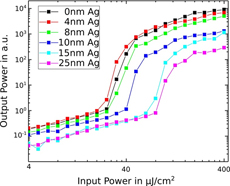Article contents
Intracavity metal contacts for organic microlasers
Published online by Cambridge University Press: 18 January 2019
Abstract

The realization of an electrically driven organic solid-state laser is an ambitious but highly desirable goal. Many obstacles need to be solved before a working device can be realized. One of the most challenging tasks is an incorporation of intracavity metal contacts, which, on the one hand, would not substantially degrade optical properties of the whole device and, on the other hand, would ensure sufficient current density to reach lasing. In this paper, we present different contact compositions aiming to realize high-quality intracavity metal contacts. We build a top contact consisting of 0.5 nm of aluminum and 4 nm of silver which has a conductivity of 1.9 × 107 (Ω/m) and is not increasing the optical lasing threshold of an organic microcavity. To get a better understanding of charge carriers influencing the device performance, we have performed a set of measurements, where a hybrid OLED–MC device was excited both optically and electrically at the same time. These experiments suggest that the charge carriers do not degrade electrical performance, at least for current densities in the range of A/cm2. Moreover, our observations suggest that, in some cases, simultaneous optical excitation can contribute to more efficient electrical pumping of the OLED-MC device.
Keywords
- Type
- Invited Feature Paper
- Information
- Copyright
- Copyright © Materials Research Society 2019
Footnotes
This paper has been selected as an Invited Feature Paper.
References
- 5
- Cited by


